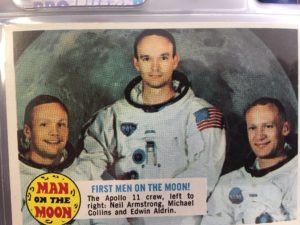By David Fleet
Editor
According to news reports, at 9:32 a.m., July 16, 1969 Apollo 11 took off from Kennedy Space Center with astronauts Neil Armstrong, Edwin Aldrin Jr.,

and Michael Collins aboard. After traveling 240,000 miles in 76 hours, Apollo 11 entered into a lunar orbit on July 19. On July 20, the Eagle began its descent to the lunar surface, and at 4:18 p.m. the Eagle landed on the southwestern edge of the Sea of Tranquility. At 10:56 p.m., Armstrong spoke his famous quote, “that’s one small step for a man, one giant leap for mankind.” He then planted his left foot on the gray, powdery surface of the moon.
At 11:11 p.m., “Buzz” Aldrin joined him on the moon’s surface. By 1:11 a.m., July 21, both astronauts were back in the lunar module and the hatch was closed. The two men slept that night on the surface of the moon. At 1:54 p.m. the Eagle began its ascent back to the command module and the return to earth.
The historic mission of Apollo 11 remembered 50 years ago today, sparked a host of advances in science and inspired generations to think behold the earth.
Dustin Scriven, a 2011 Brandon High School graduate, earned a Bachelor of Science in astrophysics from Michigan State University and is currently working on a doctorate degree in physics at Texas A & M.
“The moon walk and the Apollo missions were amazing,” said Scriven. “It took thousands of people day and night to make that happen. Science and engineers came to the call as they have in the past, like they did in World War II, arming the United States. Getting that many people to work together as a team is fantastic.”
Scriven emphasized the technology that emerged as a result of the Apollo missions. From the Apollo mission came liquid cooled suits to regulate body temperature now used by firefighters and race car drivers; freeze dried food now used in military Meals Ready to Eat; integrated circuits used in computers and guidance system, just to name a few.
In addition, the AID Implantable Automatic Pulse generator which monitors the heart continuously; aerosolized fuel for the Apollo Saturn and the Programmable Implantable Medication System (PIMS).
A 1999 Brandon High School graduate, Anthony Lapp attended Michigan Technological University and graduated in 2005. Lapp worked in Detroit based automotive industry for six years before joining the Robotics Lab at NASA’s Johnson Space Center in Houston Texas. He returned to Michigan last summer to be closer to family and is currently back to the auto industry designing and building industrial robot solutions while assisting automation in the factory processes.
“I grew up in the space shuttle era,” said Lapp. “We saw the Space Shuttle Challenger disaster and had always been interested in space. I’ve had the chance to visit Mission Control at Johnson Space Center and was on the floor.”
The Apollo era kicked off the computer boom, telecommunications, cell phones, cameras, said Lapp.
“We needed that kick start to move forward with technology,” he said.
While at NASA, Lapp was an engineer working on the steering and suspension of a dune-buggy like lunar rover for a return trip to the moon in 2022.
“This time they will focus on the exploration of the moon’s poles,” he said. “We will return to the moon before we head to Mars anytime soon. But, we can’t go back with Apollo equipment, it’s outdated now. The lunar rover requires a ton of mobility due to the very harsh climate on the moon. While Apollo provided data regarding the moon, we really still have very limited information available. It’s very costly to recreate the vacuum of space and to replicate the moon’s surface.”
Ortonville resident Ken Bush, 81, recalls the television coverage of the moon landing at his Bald Eagle Lake home in 1969.
“I’ve always been interested in the space program,” said Bush. “I have family near the Kennedy Space Center and have watched four space shuttles blasting off from about five miles away. The power is amazing—you can feel the rumble of the rocket engines. People that are watching cheer when it goes off. On a clear day you can see the shuttle go for a hundred miles down range.”
Bush has been a collector for many years which included “Man on the Moon” gum trading cards.
“Many of the items become more collectible at this time,” he said. “The moon landing is still very popular 50 years later.”
